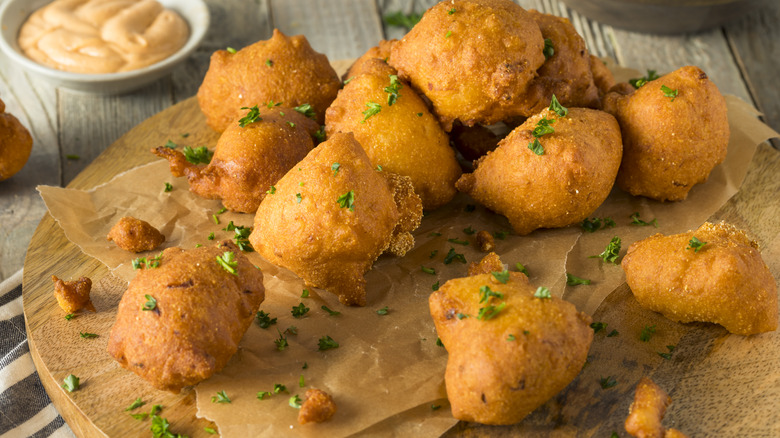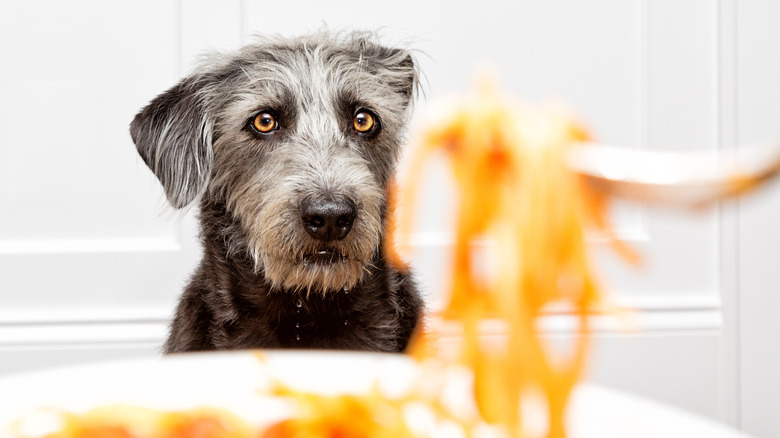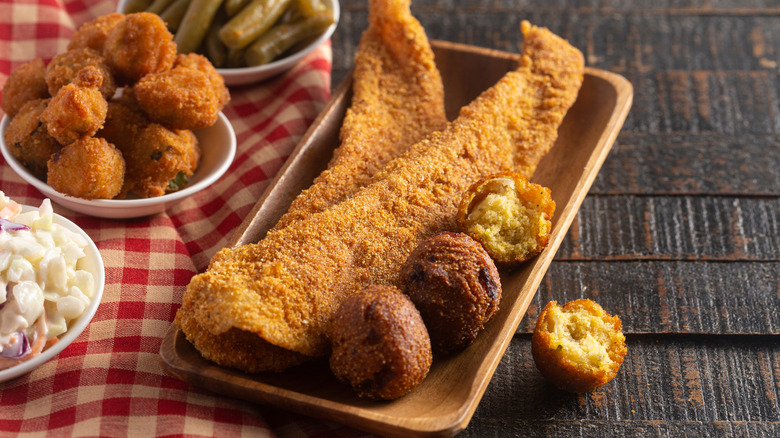The Strange Way Hush Puppies Got Their Name
Hush puppies are a staple of Southern cuisine. Typically served with barbecue, fried chicken and seafood, and alongside Cajun dishes, such as gumbo, these deep-fried cornmeal fritters are crispy on the outside with a soft, almost cake-like texture on the inside. They're the perfect vehicle for mopping up a scrumptious sauce or tempering heat from spicy foods. They're also great by themselves as a savory snack. But how on earth did they get their name? Well, for such a simple side-dish, the history of how hush puppies got their moniker is anything but straightforward.
The history of Southern cooking abounds with tall tales, local legends, and outlandish origin stories, and the myths surrounding hush puppies are no different. Most (but not all) culinary historians agree that they were first consumed in the coastal Carolinas as "red horse bread" (a bread neither red or containing horses), but the rest of their story remains mysterious. Did the Gullah Island residents give the tasty treat their name? Confederate soldiers? French nuns? Native Americans? Were they fried lizards?
While we can't confidently say one story is truer than the rest, one possible culprit is a figure many of us are familiar with: a dog begging for table scraps.
Hush puppies might have been snacks for puppies
Legend has it that long ago, when most meals were still cooked on campfires, scraps were given to hungry dogs to quiet their whining and begging. Because meat was a more precious commodity, the story goes that fried bits of batter would be tossed to the dogs to quiet them down, hence the term "hush, puppy!" One version of the tale credits Confederate soldiers for the term, as whining dogs could have given away their location to the Union army during the Civil War.
However, as Serious Eats points out, the "puppies" in question could also be a euphemism for the whines and growls human stomachs make when we're hungry. Because cornmeal fries quickly, it may have been served as a sort of appetizer, or in between meals to "quiet" hunger.
More practical explanations see hush puppies gaining popularity in the mid-1930s, when the increasing prevalence of automobiles brought vacationers to southeastern shores, where they attended large fish fries and tasted hush puppies for the first time. And as for bringing French nuns or leaping lizards into the picture, Serious Eats argues that while some tall tales may add charm to a recipe's origin story, "if we blindly accept the folklore about Southern cuisine, we're missing out on real stories that are so much more interesting than a bunch of made-up nonsense."
Hush puppies make a great side or main dish
Whichever origin story you prefer, hush puppies are delicious. Family and restaurant recipes vary slightly, mostly in the different spices used to accentuate flavors and the cornmeal-to-flour ratio. You can buy pre-made batter or start with this hush puppies recipe that adds beer to the batter for a light, airy crispiness. Add whatever spices you like and serve the hush puppies alongside your favorite meal, plain or with homemade tartar sauce. Or, serve them as you would warm dinner rolls: in a bread basket for passing, with butter (or honey butter) for spreading.
Feeling adventurous? Early Girl Eatery in Asheville, North Carolina, serves broccoli and cheese hush puppies. Gullah Gourmet suggests adding crabmeat to the batter to make "crab puppies" or dredging shrimp in the batter before frying; conch and lobster versions also exist.
Chopped ham or cooked bacon can also amp up the flavor without weighing down the batter too much. However you choose to serve your hush puppies, make sure to toss one to your pup while you're cooking.


